Daniel Busby
TempoKGAT: A Novel Graph Attention Network Approach for Temporal Graph Analysis
Aug 29, 2024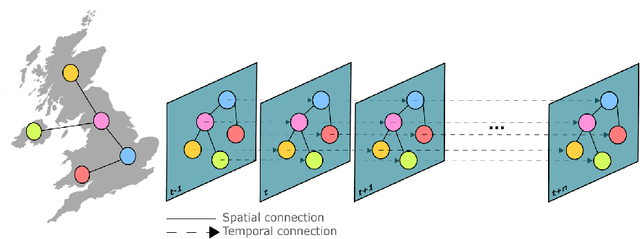

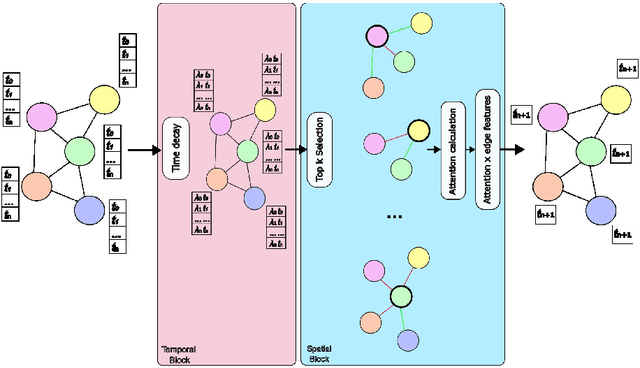
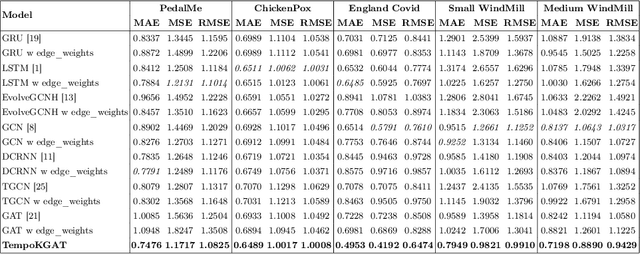
Abstract:Graph neural networks (GNN) have shown significant capabilities in handling structured data, yet their application to dynamic, temporal data remains limited. This paper presents a new type of graph attention network, called TempoKGAT, which combines time-decaying weight and a selective neighbor aggregation mechanism on the spatial domain, which helps uncover latent patterns in the graph data. In this approach, a top-k neighbor selection based on the edge weights is introduced to represent the evolving features of the graph data. We evaluated the performance of our TempoKGAT on multiple datasets from the traffic, energy, and health sectors involving spatio-temporal data. We compared the performance of our approach to several state-of-the-art methods found in the literature on several open-source datasets. Our method shows superior accuracy on all datasets. These results indicate that TempoKGAT builds on existing methodologies to optimize prediction accuracy and provide new insights into model interpretation in temporal contexts.
TG-PhyNN: An Enhanced Physically-Aware Graph Neural Network framework for forecasting Spatio-Temporal Data
Aug 29, 2024



Abstract:Accurately forecasting dynamic processes on graphs, such as traffic flow or disease spread, remains a challenge. While Graph Neural Networks (GNNs) excel at modeling and forecasting spatio-temporal data, they often lack the ability to directly incorporate underlying physical laws. This work presents TG-PhyNN, a novel Temporal Graph Physics-Informed Neural Network framework. TG-PhyNN leverages the power of GNNs for graph-based modeling while simultaneously incorporating physical constraints as a guiding principle during training. This is achieved through a two-step prediction strategy that enables the calculation of physical equation derivatives within the GNN architecture. Our findings demonstrate that TG-PhyNN significantly outperforms traditional forecasting models (e.g., GRU, LSTM, GAT) on real-world spatio-temporal datasets like PedalMe (traffic flow), COVID-19 spread, and Chickenpox outbreaks. These datasets are all governed by well-defined physical principles, which TG-PhyNN effectively exploits to offer more reliable and accurate forecasts in various domains where physical processes govern the dynamics of data. This paves the way for improved forecasting in areas like traffic flow prediction, disease outbreak prediction, and potentially other fields where physics plays a crucial role.
Knowledge-Based Convolutional Neural Network for the Simulation and Prediction of Two-Phase Darcy Flows
Apr 04, 2024Abstract:Physics-informed neural networks (PINNs) have gained significant prominence as a powerful tool in the field of scientific computing and simulations. Their ability to seamlessly integrate physical principles into deep learning architectures has revolutionized the approaches to solving complex problems in physics and engineering. However, a persistent challenge faced by mainstream PINNs lies in their handling of discontinuous input data, leading to inaccuracies in predictions. This study addresses these challenges by incorporating the discretized forms of the governing equations into the PINN framework. We propose to combine the power of neural networks with the dynamics imposed by the discretized differential equations. By discretizing the governing equations, the PINN learns to account for the discontinuities and accurately capture the underlying relationships between inputs and outputs, improving the accuracy compared to traditional interpolation techniques. Moreover, by leveraging the power of neural networks, the computational cost associated with numerical simulations is substantially reduced. We evaluate our model on a large-scale dataset for the prediction of pressure and saturation fields demonstrating high accuracies compared to non-physically aware models.
When Geoscience Meets Generative AI and Large Language Models: Foundations, Trends, and Future Challenges
Jan 25, 2024Abstract:Generative Artificial Intelligence (GAI) represents an emerging field that promises the creation of synthetic data and outputs in different modalities. GAI has recently shown impressive results across a large spectrum of applications ranging from biology, medicine, education, legislation, computer science, and finance. As one strives for enhanced safety, efficiency, and sustainability, generative AI indeed emerges as a key differentiator and promises a paradigm shift in the field. This paper explores the potential applications of generative AI and large language models in geoscience. The recent developments in the field of machine learning and deep learning have enabled the generative model's utility for tackling diverse prediction problems, simulation, and multi-criteria decision-making challenges related to geoscience and Earth system dynamics. This survey discusses several GAI models that have been used in geoscience comprising generative adversarial networks (GANs), physics-informed neural networks (PINNs), and generative pre-trained transformer (GPT)-based structures. These tools have helped the geoscience community in several applications, including (but not limited to) data generation/augmentation, super-resolution, panchromatic sharpening, haze removal, restoration, and land surface changing. Some challenges still remain such as ensuring physical interpretation, nefarious use cases, and trustworthiness. Beyond that, GAI models show promises to the geoscience community, especially with the support to climate change, urban science, atmospheric science, marine science, and planetary science through their extraordinary ability to data-driven modeling and uncertainty quantification.
Generation of non-stationary stochastic fields using Generative Adversarial Networks with limited training data
May 11, 2022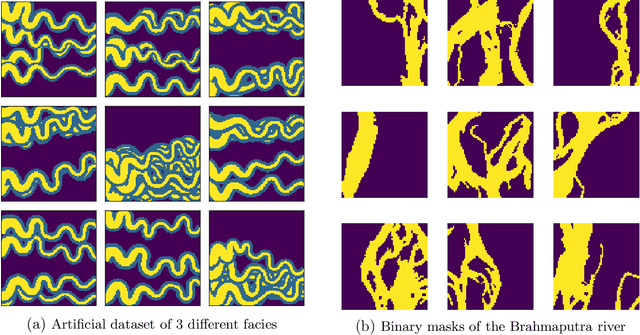
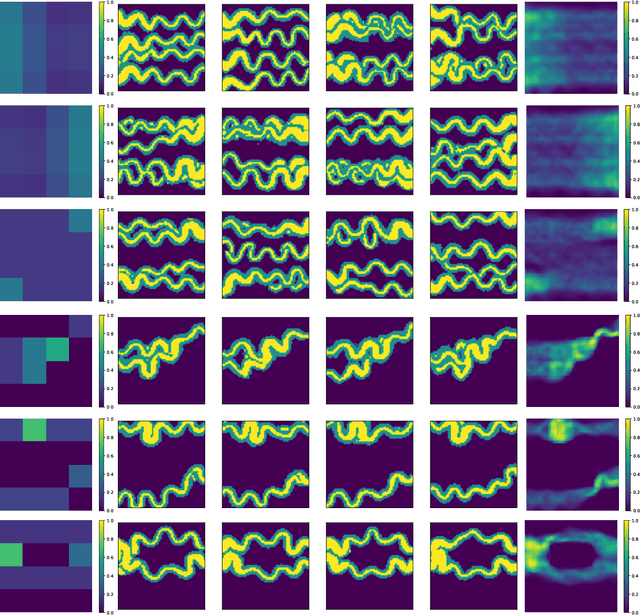
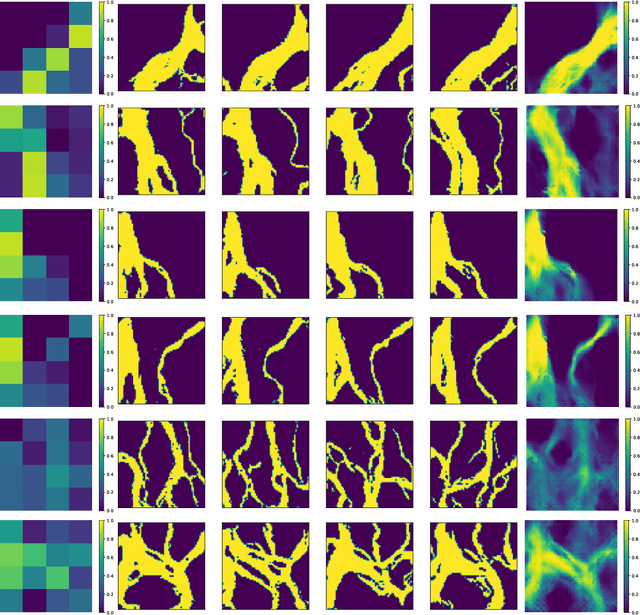
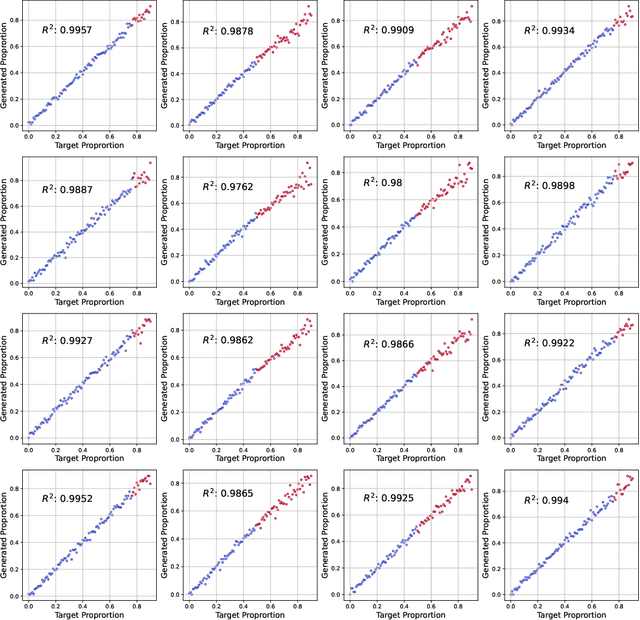
Abstract:In the context of generating geological facies conditioned on observed data, samples corresponding to all possible conditions are not generally available in the training set and hence the generation of these realizations depends primary on the generalization capability of the trained generative model. The problem becomes more complex when applied on non-stationary fields. In this work, we investigate the problem of training Generative Adversarial Networks (GANs) models against a dataset of geological channelized patterns that has a few non-stationary spatial modes and examine the training and self-conditioning settings that improve the generalization capability at new spatial modes that were never seen in the given training set. The developed training method allowed for effective learning of the correlation between the spatial conditions (i.e. non-stationary maps) and the realizations implicitly without using additional loss terms or solving a costly optimization problem at the realization generation phase. Our models, trained on real and artificial datasets were able to generate geologically-plausible realizations beyond the training samples with a strong correlation with the target maps.
Generating unrepresented proportions of geological facies using Generative Adversarial Networks
Mar 17, 2022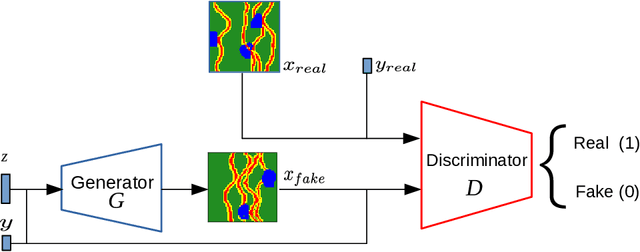



Abstract:In this work, we investigate the capacity of Generative Adversarial Networks (GANs) in interpolating and extrapolating facies proportions in a geological dataset. The new generated realizations with unrepresented (aka. missing) proportions are assumed to belong to the same original data distribution. Specifically, we design a conditional GANs model that can drive the generated facies toward new proportions not found in the training set. The presented study includes an investigation of various training settings and model architectures. In addition, we devised new conditioning routines for an improved generation of the missing samples. The presented numerical experiments on images of binary and multiple facies showed good geological consistency as well as strong correlation with the target conditions.
 Add to Chrome
Add to Chrome Add to Firefox
Add to Firefox Add to Edge
Add to Edge